DSC PG9985 Handleiding
Bekijk gratis de handleiding van DSC PG9985 (4 pagina’s), behorend tot de categorie Detector. Deze gids werd als nuttig beoordeeld door 104 mensen en kreeg gemiddeld 3.9 sterren uit 52.5 reviews. Heb je een vraag over DSC PG9985 of wil je andere gebruikers van dit product iets vragen? Stel een vraag
Pagina 1/4

PG9985/PG8985/PG4985
PowerG Wireless Flood Detector Installation
Instructions
Operation
The PG9985/PG8985/PG4985 are fully supervised two-way,
indoor PowerG flood detectors. The PG9985/PG8985/
PG4985 continuously monitor for unacceptable water levels.
If water is detected (e.g., when both probes are in contact
with the water), the PG9985/PG8985/PG4985 wirelessly
communicates an alarm condition to the alarm system.
The tamper switch is activated when the cover is removed. In
addition, the device sends a probe disconnection alert upon
the detection of a probe terminal connection failure.
An LED lights whenever alarm or tamper events are reported.
The LED does not light while a supervision message is being
transmitted.
Operating power is obtained from a 3V Lithium battery.
When the battery voltage is low, a “low battery” message is
sent to the receiver.
After every flood detection, each flood detector should be
cleaned and dried.
Device Setup
Caution! To be installed by service persons in non-hazardous
locations only. Risk of explosion if battery is replaced by an
incorrect type. Observe polarity when installing batteries.
Dispose of used batteries according to the manufacturer's
instructions and according to local rules and regulations.
Note: To ensure the continued operation of all wireless
devices after performing a system default, a global upload of
all wireless programming via DLS is recommended before
defaulting the system. After completing the system default,
download the wireless programming.
Legend
A. Transmission LED
B. Terminal block for sensor
C. Enroll button
D. Tamper switch
E. Mounting holes
F. Break-away tamper
Install the battery
1. Insert a flat-edged screw-
driver into the slot and
push upward to remove
cover.
2. Remove the screw
and separate the
cover from the base.
3. Observe polarity
and install battery.
4. Connect the sensor wire to the
terminal block.
Note: When manually programming
wireless devices, if a device has
been powered up for more than 48
hours it cannot be enrolled into the
system until the device has been
tampered and restored. When programming the panel using
the Quick Enroll procedure follow the steps detailed in Enroll
the Device into the System.
Note: After restoring a low battery trouble the system may
take up to 5 minutes to clear the trouble.
Enroll the Device into the System
To quick enroll:
1. On a keypad press [*] [8] [Installer Code] [804] [000].
2. Press and hold the device enroll button until the LED
lights steady and then release the enroll button while the
LED is still lit. A confirmation message then appears on
the keypad.
3. Press [*] key to confirm ID.
4. Enter [3 digit zone #].
5. Enter [3 digit zone type].
6. Enter [1 digit partition #] for all desired partitions and
press [#]. If using an LCD keypad you can scroll to the
desired partitions and press [*] to toggle the partition.
7. On an LCD keypad enter the label by using word library.
To pre-enroll:
1. Remotely configure the unique ID number into the sys-
tem. For more information see the HSM2HOST manual.
2. When on-site, press the device enroll button.
Note: If the wireless device has been powered for more than
48 hours without being enrolled, tamper and restore the
device to enroll it.
Perform a placement test
Before permanently mounting any wireless device, temporar-
ily mount the device and perform a Placement test with the
water sensor connected.
1. Tamper the device.
2. Restore the tamper. The device now enters Placement
test mode for 15 minutes.
3. The red LED blinks once to identify that a signal is being
sent to the receiver and then blinks three times to identify
the signal strength. The following table indicates the
received signal strength.
IMPORTANT! Only GOOD or STRONG signal strengths
are acceptable. If you receive a POOR signal from the device,
re-locate it and re-test until a GOOD or STRONG signal is
received.
Note: For UL/ULC installations, only STRONG signal levels
are acceptable. After installation verify the product function-
ality in conjunction with the compatible receivers
HSM2HOST9, HS2LCDRF(P)9, HS2ICNRF(P)9 and
PG9920.
Note: For detailed Placement instructions refer to the control
panel Reference Guide.
Mount the Device
Notes: Avoid mounting the transmitter portion of the device
behind a metal object such as a washing machine, refrigera-
tor, or freezer. RF signals can be affected by metal objects.
After every flood detection, each flood detector should be
cleaned and dried. Otherwise, the unit may not operate as
intended due to the nature of different liquids.
Note: Adhesive tape not to be used for EU Market.
1. Install the flood sensor in the lowest point in the room or
where water is expected to pool with at least 2 supplied
screws. The flood sensor must be mounted so both
probes of the device are touching water when an alarm
condition is desired.
2. Secure the flood sensor cable to the wall. The flood sen-
sor should be installed only in a vertical position and fac-
ing downward.
3. Attach the flood transmitter to the wall. The flood trans-
mitter should be placed as high up as possible on the wall
to improve communication and to prevent the flood
detector itself from coming into contact with water in the
event of flooding.
4. Remove the PCB board.
5. Mark and drill 2 holes
in the mounting sur-
face and fasten the
base with 2 counter-
sunk screws. If using
the break-away tam-
per, secure with an
additional screw.
6. Reattach the PCB, and
reattach the cover to
the base.
Note: External wiring shall be routed and protected in a man-
ner that prevents:
• excessive strain on wire and terminal connections
• loosening of terminal connections
• damage of conductor insulation
• developing any other type of hazard (e.g. tripping due
to loose cables.)
Configuration
To enter the wireless configuration section enter [804][Zone
Number].
Device Toggles
Specifications
Frequency Band: CE Listed PG4985: 433MHz; CE/EN
listed PG8985: 868MHz; FCC/IC/UL/ULC listed PG9985:
912-919 MHz
Communication Protocol: PowerG
Alarm Input: External flood probe
Supervision: Signaling at 4-min. intervals
Battery type: 3 V Lithium CR-123 type battery, Panasonic
or GP only.
Battery Life Expectancy: 8 years (not tested by UL/ULC)
Low Battery Threshold: 2.2 V
Battery Supervision: Automatic transmission of battery
condition data as part of periodic status report and immedi-
ately upon low battery condition detection.
Temperature Range: -10°C to +55°C (UL/ULC only veri-
fied the range 0° to 49°C)
Humidity: up to max. 93%RH, non-condensing
Dimensions:
(LxWxD)81 x 34 x 25 mm (3-3/16 x 1-1/4 x 1 in.)
Weight (including battery): 53g (1.9 oz)
Compatible Receivers
433MHz Band: HSM2HOST4; HS2LCDRF(P)4;HS2IC-
NRF(P)4; PG4920
868MHz Band: HSM2HOST8; HS2LCDRF(P)8; HS2IC-
NRF(P)8;PG8920
912-919MHz Band: HSM2HOST9; HS2LCDRF(P)9;
HS2ICNRF(P)9; PG9920
Note: Only devices operating in band 912-919MHz are UL/
ULC listed.
UL/ULC Notes
Only model PG9985 operating in the frequency band 912-919MHz are UL/ULC listed. The PG9985 has
been listed by UL//cUL under UL2017 requirements.
For UL/ULC installations use these devices only in conjunction with compatible DSC wireless receivers:
HSM2HOST9, HS2LCDRF(P)9, HS2ICNRF(P)9 and PG9920. After installation verify the product
functionality in conjunction with the compatible receiver used.
Europe: The PG8985 and PG4985 are compliant with the RTTE requirements -
Directive 1999/5/EC of the European Parliament and of the Council of 9 March 1999.
The Power G peripheral devices have two- way communication functionality,
providing additional benefits as described in the technical brochure. This
functionality has not been tested to comply with the respective technical requirements and should
therefore be considered outside the scope of the product’s certification
FCC COMPLIANCE STATEMENT
WARNING! Changes or modifications to this unit not expressly approved by the party responsible for
compliance could void the user’s authority to operate the equipment.
This device has been tested and found to comply with the limits for a Class B digital device, pursuant to
Part 15 of the FCC Rules. These limits are designed to provide reasonable protection against harmful
interference in residential installations. This equipment generates uses and can radiate radio frequency
energy and, if not installed and used in accordance with the instructions, may cause harmful interference
to radio and television reception.
However, there is no guarantee that interference will not occur in a particular installation. If this device
does cause such interference, which can be verified by turning the device off and on, the user is
encouraged to eliminate the interference by one or more of the following measures:
– Re-orient or re-locate the receiving antenna.
– Increase the distance between the device and the receiver.
– Connect the device to an outlet on a circuit different from the one that supplies power to the receiver.
– Consult the dealer or an experienced radio/TV technician.
This equipment complies with FCC and IC RF radiation exposure limits set forth for an uncontrolled
environment.
This device complies with FCC Rules Part 15 and with Industry Canada licence-exempt RSS standard(s).
Operation is subject to the following two conditions: (1) This device may not cause harmful interference,
and (2) this device must accept any interference that may be received or that may cause undesired
operation.
Le present appareil est conforme aux CNR d'Industrie Canada applicables aux appareils radio exempts de
licence. L'exploitation est autorisee aux deux conditions suivantes :(1) l'appareil ne doit pas produire de
brouillage, et (2) l'utilisateur de l'appareil doit accepter tout brouillage radioelectrique subi, meme si le
brouillage est susceptible d'en compromettre le fonctionnement.
PG9985/PG8985/PG4985
Instructions d'installation du détecteur d'inonda-
tion au sol sans fil de la gamme PowerG
Fonctionnement
Les PG9985/PG8985/PG4985 sont des détecteurs d'inonda-
tion d'intérieur, bidirectionnels, sans fil, entièrement sur-
veillés de la gamme PowerG. Les PG9985/PG8985/PG4985
surveillent de façon continue les niveaux d'eau inacceptables.
Si de l'eau est détectée (par exemple, quand les deux sondes
sont en contact avec de l'eau), les PG9985/PG8985/PG4985
communiquent par liaison sans fil un état d'alarme au sys-
tème d'alarme.
Le contact anti-sabotage est activé quand le couvercle est
retiré. En plus, il transmet une alerte de déconnexion de la
sonde à la suite de la détection d'un problème de connexion
d'une borne de la sonde.
Un voyant lumineux s'allume chaque fois que des événe-
ments de sabotage ou d'alarme sont signalés. Le voyant
lumineux ne s'allume pas alors qu'un message de surveillance
est en cours de transmission.
L'alimentation est fournie par une pile au lithium de 3 V.
Quand la tension de la pile est faible, un message de niveau
faible de pile est transmis au récepteur.
Après chaque détection d'inondation, chaque détecteur
d'inondation doit être nettoyé et séché.
Réglage du dispositif
Attention ! À faire installer par un agent de service dans des
zones non dangereuses uniquement. Risque d'explosion si la
pile n'est pas du type correct. Respecter les polarités lors de
l'installation des piles. Éliminer les piles usagées selon les
recommandations du fabricant, les lois et réglementations
locales.
Remarque : Pour garantir le fonctionnement continu de tous
les dispositifs sans fil après avoir réalisé une réinitialisation aux
valeurs par défaut, un téléchargement général de toute la pro-
grammation sans fil par DLS est recommandé avant de réini-
tialiser le système. Après avoir complété la réinitialisation aux
valeurs par défaut du système, téléchargez la programmation
sans fil.
Légende
A. Voyant lumineux de transmission
B. Bornier du capteur
C. Bouton d'attribution
D. Contact anti-sabotage
E. Trous de fixation
F. Contact anti-sabotage
Installer la pile
1. Insérez un tournevis plat
dans la fente et poussez
vers le haut pour retirer le
couvercle.
2. Retirez la vis et
détachez le
couvercle de la
base.
3. Respectez les
polarités et installez la pile.
4. Branchez les fils du détecteur
au bornier.
Remarque : Quand vous program-
mez manuellement les dispositifs
sans fil, si un dispositif a été ali-
menté pendant plus de 48 heures, il
ne peut pas être attribué dans le sys-
tème tant que le dispositif n'a pas été saboté et rétabli.
Remarque: Après la restauration d'un défaut de batterie
faible, le système peut prendre jusqu'à 5 minutes pour que la
peine.
Attribuez le dispositif dans le système
Pour une attribution rapide :
1. Sur le pavé numérique, appuyez sur [*] [8] [Code de
l'installateur] [804] [000].
2. Appuyez de façon prolongée sur le bouton d'attribution
du dispositif tant que le voyant lumineux reste allumé,
puis relâchez- le bouton d'attribution alors que le voyant
lumineux est encore allumé. Un message de
confirmation apparaît alors sur le pavé numérique.
3. Appuyez sur la touche [*] pour confirmer le ID.
4. Entrez le [n° de zone à 3 chiffres].
5. Entrez les [3 chiffres de type de zone].
6. Entrez le [n° de partition à 1 chiffre] pour toutes les
partitions souhaitées et appuyez sur [#]. Si vous utilisez
un pavé numérique à cristaux liquides LCD, vous pouvez
faire défiler les partitions souhaitées et appuyer sur [*]
pour basculer la partition.
7. Sur un pavé numérique LCD, entrez la référence en
utilisant la bibliothèque de mot.
Pour une attribution préalable :
1. Configurez à distance le numéro ID unique dans le
système. Pour plus d'informations, consultez le manuel
HSM2HOST.
2. Sur site, appuyez sur le bouton d'attribution du dispositif.
Remarque : Si le dispositif sans fil a été alimenté pendant
plus de 48 heures sans être attribué, sabotez et rétablissez le
dispositif pour l'attribuer.
Réalisation d'un test de positionnement
Avant de fixer de façon permanente un dispositif sans fil
quelconque, montez-le temporairement et effectuez un test de
positionnement avec le détecteur d'inondation connecté.
1. Sabotez le dispositif.
2. Rétablissez le système anti-sabotage. Le dispositif passe
en mode de test de positionnement pendant 15 minutes.
3. Le voyant lumineux rouge clignote une fois pour
indiquer qu'un signal est transmis au récepteur, puis
clignote trois fois pour fournir la force du signal. Le
tableau suivant décrit la force de signal reçu.
IMPORTANT ! Seules les forces de signal FORT ou BON
sont acceptables. Si vous recevez un signal FAIBLE du dis-
positif, déplacez-le et testez-le à nouveau jusqu'à ce qu'un
signal BON ou FORT soit reçu.
A
+
-
C
D
B
LED response Signal Strength
Green LED blinks STRONG
Orange LED blinks GOOD
Red LED blinks POOR
No blinks No communication
Floor
Avoid locating
near metal
objects
SENSOR
WIRE
TRANSMITTER
DG009365
SENSOR
Washing
Machine
[001][04] Supervision - Default [Y]
Enables supervision of the device.
E
F
Réponse du voyant Force du signal
Le voyant vert clignote FORT
Le voyant orange clignote BON
Le voyant rouge clignote FAIBLE
Aucun clignotement Aucune communication
A
+
-
C
D
B
D-304678

Remarque : Pour les installations UL/ULC, seul un signal
FORT est acceptable. Après installation, vérifiez les fonction-
nalités de l'appareil en association avec les récepteurs com-
patibles HSM2HOST9, HS2LCDRF(P)9, HS2ICNRF(P)9 et
PG9920.
Remarque : Pour des instructions détaillées sur le posi-
tionnement, consultez le guide de référence de la centrale.
Installation de l'appareil
Remarques : Évitez de fixer la partie émettrice du dispositif
derrière un objet métallique comme une machine à laver, un
réfrigérateur ou un congélateur. Les signaux RF peuvent être
altérés par les objets métalliques. Après chaque détection
d'inondation, chaque détecteur d'inondation doit être nettoyé
et séché. Sinon l'unité peut ne pas fonctionner comme prévu
en raison de la nature des différents liquides.
Remarque : Ruban adhésif ne doit pas être utilisé pour le
marché de l'UE.
1. Installez le capteur d'inondation au point le plus bas de la
pièce et où l'eau est supposée arrivée avec au moins 2 vis
fournies. Le capteur d'inondation sol doit être monté de
sorte que les deux sondes du dispositif touchent l'eau au
niveau où l'état d'alarme voulu est déclenché.
2. Fixez le câble du capteur d'inondation au mur. Le capteur
d'inondation doit être installé exclusivement en position
verticale et face vers le bas.
3. Fixez l'émetteur du capteur d'inondation au mur.
L'émetteur du détecteur d'inondation doit être placé le
plus haut possible sur le mur afin d'obtenir une bonne
communication et éviter que le détecteur d'inondation
entre en contact direct avec l'eau en cas d'inondation.
4. Retirez la carte de
circuit imprimé.
5. Marquez et percez 2
trous dans la surface
de montage et fixez la
base avec 2 vis
fraisées. Si vous
utilisez le contact anti-
sabotage, fixez-le avec
une autre vis.
6. Remontez la carte de circuit imprimé et réassemblez le
couvercle sur la base.
Remarque : Le câblage externe doit être acheminé et protégé
de manière à éviter :
• des contraintes excessives sur les fils et les bornes de
raccordement
• le desserrage des bornes de raccordement
• des dommages à l'isolant du conducteur
• le développement de tout autre type de risque (par
exemple, chute en raison de câbles mal fixés.)
Configuration
Pour accéder à la section de configuration sans fil, entrez la
commande [804][n° de la zone à 3 chiffres].
Commutateurs du dispositif
Caractéristiques techniques
Bande de fréquences : PG4985 homologué CE : 433 MHz ;
PG8985 homologué CE/EN : 868 MHz ; PG9985 homologué
FCC/IC/UL/ULC : 912-919 MHz
Protocole de communication : PowerG
Entrée d'alarme : Sonde d'inondation externe
Surveillance : Signalisation par intervalles de 4 mn.
Type de pile : Pile au lithium de type CR-123, exclusivement
Panasonic et GP.
Durée de vie estimée de la pile : 8 ans (non vérifiés par UL/
ULC)
Seuil de niveau faible de pile : 2,2 V
Surveillance de pile : Transmission automatique de l'état de
la pile comme partie intégrante du rapport d'état périodique et
suivie immédiatement de la détection de l'état de niveau
faible de pile.
Plage de température : de -10 °C à +55 °C (l'organisme UL/
ULC a vérifié uniquement la plage de 0 °C à 49 °C)
Humidité : Jusqu'à 93 % max., sans condensation
Dimensions :
(L x l x P) 81 x 34 x 25 mm (3-3/16 x 1-1/4 x 1 po.)
Poids (pile incluse) : 53 g (1,9 oz)
Récepteurs compatibles
Bande de 433 MHz : HSM2HOST4; HS2LCDRF(P)4;
HS2ICNRF(P)4; PG4920
Bande de 868MHz : HSM2HOST8; HS2LCDRF(P)8;
HS2ICNRF(P)8; PG8920
Bande de 912-919 MHz : HSM2HOST9; HS2LCDRF(P)9;
HS2ICNRF(P)9; PG9920
Remarque : Seuls les dispositifs fonctionnant dans la bande
912-919 MHz sont référencés UL/ULC.
Remarques UL/ULC
Seul le modèle PG9985 fonctionnant dans la bande de fréquences 912-919 MHz est homologué UL/
ULC. Le PG9985 est homologué UL/cUL sous UL2017 exigences.
Pour les installations UL/ULC, utilisez uniquement ces dispositifs en association avec des récepteurs
sans fil DSC compatibles : HSM2HOST9, HS2LCDRF(P)9, HS2ICNRF(P)9 et PG9920. Après
installation, vérifiez les fonctionnalités du produit en association avec le du récepteur compatible utilisé.
Europe : Le PG8985 est la PG4985 sont compatible avec la réglementation RTTE :
directive 1995/5/EC du Parlement Européen et du Conseil du 9 mars 1999. Les
dispositifs périphériques Power G DD243sont dotés d'une fonction de
communication bidirectionnelle, offrant des avantages supplémentaires comme décrit
dans la brochure technique. Cette fonction n'a pas été déclarée conforme aux besoins techniques
respectifs et doit, par conséquent, être exclue de la certification du produit
PowerG PG9985/PG8985/PG4985
Instrucciones de instalación del detector de inun-
dación inalámbrico
Operación
Los detectores de inundación PowerG modelos PG9985/
PG8985/PG4985 son totalmente supervisados, de dos vías y
de uso interior. Monitorean continuamente niveles de agua
inaceptables. Si se detecta agua (por ejemplo, cuando ambas
sondas están en contacto con el agua), los modelos PG9985/
PG8985/PG4985 comunican de forma inalámbrica una
condición de alarma al sistema de alarma.
El interruptor contra manipulación se activa cuando se retira
la cubierta. Además, envía una alerta de desconexión de la
sonda al detectar una falla de conexión de la terminal de la
sonda.
Un LED se enciende siempre que se informen eventos de
alarma o manipulación. El LED no se enciende mientras se
transmite un mensaje de supervisión.
La alimentación de operación se obtiene de una batería de
litio de 3 V. Cuando el voltaje de la batería es bajo, un men-
saje de batería baja se envía al receptor.
Después de cada detección de inundación, cada detector de
inundación debe limpiarse y secarse.
Configuración del dispositivo
¡Precaución! Para ser instalado por personal de servicio
técnico solo en ubicaciones no peligrosas. Riesgo de
explosión si la batería es reemplazada por otra del tipo incor-
recto. Observe la polaridad al instalar las baterías. Deseche
las baterías usadas según las instrucciones del fabricante y de
acuerdo con los reglamentos y leyes locales.
Nota: Para asegurar la operación continuada de todos los dis-
positivos inalámbricos después de realizar un puesta del
sistema a sus valores predeterminados, se recomienda
realizar una carga global de toda la programación inalámbrica
vía DLS antes de poner el sistema en sus valores predetermi-
nados. Después de terminar la puesta del sistema a sus
valores predeterminados, descargue la programación inalám-
brica.
Leyenda
A. LED de transmisión
B. Bloque de terminales para el sensor
C. Botón de asociar
D. Interruptor contra manipulación
E. Agujeros de montaje
F. Sello de manipulación por rotura
Instale la batería
1. Inserte un destornillador
plano en la ranura y
empuje hacia arriba para
retirar la cubierta.
2. Retire el tornillo y
separe la cubierta de
la base.
3. Observe la
polaridad e instale
la batería.
4. Conecte el
conductor del sensor al bloque
de terminales.
Nota: Al programar manualmente
los dispositivos inalámbricos, si un
dispositivo p2-ha estado alimentado por
más de 48 horas, no podrá asociarse
en el sistema hasta que haya sido
manipulado y restaurado.
Nota: Después de restaurar un problema de batería baja, el
sistema puede tardar hasta 5 minutos para eliminar el prob-
lema.
Asocie el dispositivo al sistema
Para asociar rápidamente:
1. En el teclado numérico, pulse [*] [8] [Código del
instalador] [804] [000].
2. Pulse y mantenga pulsado el botón para asociar el
dispositivo hasta que el LED se encienda de forma
continua y luego suelte el botón mientras el LED aún
está encendido. Aparecerá un mensaje de confirmación
en el teclado numérico.
3. Pulse la tecla [*] para confirmar el número de ID.
4. Ingrese el [número de zona de 3 dígitos].
5. Ingrese el [tipo de zona de 3 dígitos].
6. Ingrese [el número de partición de 1 dígito] para todas
las particiones deseadas y pulse [#]. Si usa un teclado
numérico LCD, puede desplazarse a las particiones
deseadas y pulsar [*] para alternar entre particiones.
7. En un teclado numérico LCD, ingrese la etiqueta usando
la biblioteca de palabras.
Para realizar una asociación previa:
1. Configure de forma remota el número de ID único en el
sistema. Si desea más información, consulte el manual
del HSM2HOST.
2. Cuando esté en el lugar, pulse el botón para asociar el
dispositivo.
Nota: Si el dispositivo inalámbrico p2-ha estado alimentado por
más de 48 horas sin ser asociado, manipule el dispositivo y
restáurelo para asociarlo.
Realice una prueba de colocación
Antes de montar permanentemente cualquier dispositivo
inalámbrico, monte el dispositivo temporalmente y realice
una prueba de colocación con el sensor de agua conectado.
1. Manipule el dispositivo.
2. Restablezca la protección contra manipulación. El
dispositivo ahora entra en el modo de prueba de
colocación durante 15 minutos.
3. El LED rojo parpadea una vez para identificar que una
señal se está enviando al receptor y después parpadea
tres veces para identificar la potencia de la señal. La
tabla siguiente indica la potencia de la señal recibida.
¡IMPORTANTE! Solamente las potencias de señal BUENA
o FUERTE son aceptables. Si usted recibe una señal BAJA
del dispositivo, reubíquelo y vuelva a probarlo hasta que
reciba una señal BUENA o FUERTE.
Nota: Para instalaciones UL/ULC, solamente los niveles de
señal FUERTE son aceptables. Después de la instalación,
verifique la funcionalidad del producto junto con los recep-
tores compatibles HSM2HOST9, HS2LCDRF(P)9, HS2IC-
NRF(P)9 y PG9920.
Nota: Puede encontrar instrucciones detalladas sobre la colo-
cación en la Guía de referencia del panel de control.
Monte el dispositivo
Notas: Evite montar la parte del transmisor del dispositivo
detrás de un objeto de metal, tal como una lavadora, un
refrigerador o un congelador. Las señales de RF se pueden
afectar por objetos de metal. Después de cada detección de
inundación, cada detector de inundación debe limpiarse y
secarse. De no hacerlo, la unidad podría no funcionar como
está previsto debido a la naturaleza de los diferentes líquidos.
Nota: La cinta adhesiva no debe ser usado para el mercado de
la UE.
1. Instale el sensor de inundación en el punto más bajo del
cuarto o donde se espera que el agua se acumule
utilizando al menos 2 tornillos suministrados. El sensor
de inundación debe montarse de modo que ambas sondas
del dispositivo estén tocando el agua cuando se desea
una condición de alarma.
2. Asegure el cable del sensor de inundación a la pared. El
sensor de inundación debe instalarse solamente en una
posición vertical y orientado hacia abajo.
3. Fije el transmisor de inundación a la pared. El transmisor
de inundación debe colocarse tan arriba como sea
posible en la pared para mejorar la comunicación y evitar
que el detector de inundación mismo entre en contacto
con agua en caso de inundación.
4. Retire el tablero PCB.
5. Marque y taladre 2
agujeros en la
superficie de montaje
y sujete la base con 2
tornillos avellanados.
Si usa el sello de
manipulación por
rotura, asegúrelo con
un tornillo adicional.
6. Reinstale el PCB y
reinstale la cubierta en la base.
Nota: El cableado externo debe tenderse y protegerse de una
forma que prevenga:
• tensión excesiva sobre el alambre y las conexiones de
las terminales
• aflojamiento de las conexiones de las terminales
• daño del aislamiento del conductor
• desarrollar cualquier otro tipo de peligro (por ejemplo,
tropezar debido a cables sueltos)
Restablecer dispositivo a configu-
ración predeterminada
Pulse y mantenga pulsado el botón de asociar. El LED se
encenderá de forma continua y después destellará tres veces.
Suelte el botón de asociar.
Configuración
Para ingresar a la sección de configuración inalámbrica ingrese
[804][número de zona de 3 dígitos].
Conmutadores de dispositivo
Especificaciones
Banda de frecuencia: PG4985 homologado por CE: 433
MHz; PG8985 homologado por CE/EN: 868 MHz; PG9985
homologado por FCC/IC/UL/ULC: 912-919 MHz
Protocolo de comunicación: PowerG
Entrada de alarma: Sonda externa de inundación
Supervisión: Señalización a intervalos de 4 minutos
Tipo de batería: Litio, 3 V, CR-123, Panasonic o GP
solamente.
Vida útil de la batería: 8 años (no verificado por UL/ULC)
Umbral de batería baja: 2,2 V
Supervisión de la batería: Transmisión automática de los
datos de la condición de la batería como parte del informe
periódico de estado e inmediatamente que se detecte la
condición de batería baja.
Rango de temperatura: -10 °C a +55 °C (UL/ULC solo
verificó el rango entre 0 °C a
49 °C)
Humedad: hasta 93% como máximo de humedad relativa,
sin condensación
Dimensiones: (LargoxAnchoxFondo) 81 x 34 x 25 mm (3-3/
16 x 1-1/4 x 1/2 pulg.)
Peso (incluyendo batería): 53 g (1,9 oz)
Receptores compatibles
Banda de 433 MHz: HSM2HOST4;
HS2LCDRF(P)4;HS2ICNRF(P)4; PG4920
Banda de 868 MHz: HSM2HOST8; HS2LCDRF(P)8;
HS2ICNRF(P)8;PG8920
Banda de 912-919 MHz: HSM2HOST9; HS2LCDRF(P)9;
HS2ICNRF(P)9; PG9920
Nota: Solo los dispositivos que operan en la banda de 912-
919 MHz están homologados por UL/ULC.
Notas UL/ULC
Solo el modelo PG9985 que opera en la banda de frecuencia de 912-919 MHz está homologado por UL/
ULC. La sirena PG9985 p2-ha sido homologada por UL / cUL bajo los requisitos de UL2017.
Para instalaciones UL/ULC use estos dispositivos solamente con receptores inalámbricos DSC
compatibles: HSM2HOST9, HS2LCDRF(P)9, HS2ICNRF(P)9 y PG9920. Después de la instalación,
verifique la funcionalidad del producto junto con el receptor compatible utilizado.
Europa: El modelo PG8985 y PG4985 cumple con los requisitos de RTTE - Directiva
1999/5/EC del Parlamento Europeo y del Consejo del 9 de marzo de 1999. Los
dispositivos periféricos Power G tienen funcionalidad de comunicación de dos vías,
lo que proporciona ventajas adicionales como se describen en el folleto técnico. No
se p2-ha probado que estas funciones cumplan con los requisitos técnicos correspondientes y, por lo tanto,
deberían considerarse fuera del alcance de la certificación del producto
Instruções de Instalação do Detec-
tor Sem Fio PowerG PG9985/
PG8985/PG4985
Funcionamento
Os modelos PG9985/PG8985/PG4985 são detectores de
inundação interior PowerG duas vias, totalmente supervisio-
nado. Os modelos PG9985/PG8985/PG4985 monitoram con-
tinuamente os níveis de água inaceitáveis. Se for detectada
água (por ex. quando as duas sondas estão em contato com a
água), os modelos PG9985/PG8985/PG4985 comunicam sem
fio um estado de alarme ao sistema de alarme.
O comutador de bloqueio é ativado sempre que a tampa é
removida. Para além disso, envia uma alerta de desligamento
[001][04] Supervision : Valeur par défaut [O]
Active la supervision
Floor
Avoid locating
near metal
objects
SENSOR
WIRE
TRANSMITTER
SENSOR
Washing
Machine
Sol
CAPTEUR
FILS DU
CAPTEUR
ÉMETTEUR
Machine
à laver
Éviter de le placer
près d'objets métal-
liques
E
F
A
+
-
C
D
B
Respuesta del LED Intensidad de señal
El LED verde parpadea FUERTE
El LED naranja parpadea BUENA
El LED rojo parpadea BAJA
No parpadea Ninguna comunicación
Floor
Avoid locating
near metal
objects
SENSOR
WIRE
TRANSMITTER
SENSOR
Washing
Machine
Piso
SENSOR
ALAMBRE
DEL SENSOR
TRANSMISOR
Lavadora
No lo coloque
cerca de objetos de
metal
E
F
[001][04] Supervisión - Predeterminado [S]
Habilita la supervisión.

da sonda depois da detecção de uma falha na conexão do ter-
minal da sonda.
Um LED acende-se sempre que são reportados eventos de
bloqueio ou alarme. O LED não acende sempre que a men-
sagem de supervisão está sendo transmitida.
A alimentação de funcionamento é obtida a partir de uma
bateria de lítio de 3V. Quando a voltagem da bateria está
fraca, é enviada uma mensagem de "bateria fraca" para o
receptor.
Depois de cada detecção de inundação, cada detector de
inundação deve ser limpo e seco.
Configurar Dispositivo
Cuidado! Deve ser instalada por pessoas qualificadas apenas
em locais não perigosos. Risco de explosão se a bateria for
substituída por um tipo incorreto. Respeitar a polaridade
quando instalar as baterias. A eliminação das baterias usadas
deve estar de acordo com as instruções do fabricante e con-
forme as regulamentações e normas locais.
Nota: Para garantir um funcionamento contínuo de todo os
dispositivos sem fio depois de executar uma predefinição do
sistema é recomendado um carregamento global da pro-
gramação de todos os dispositivos sem fio através DLS antes
de padronizar o sistema. Depois de concluir a predefinição do
sistema, faça o download da programação sem fio.
Legenda
A. LED de transmissão
B. Bloco do terminal para o sensor
C. Botão de registro
D. Comutador de Bloqueamento
E. Orifícios de montagem
F. Bloqueio de ruptura
Instale a bateria
1. Introduza uma chave de
fenda de cabeça plana na
ranhura e pressione para
frente para remover a
tampa.
2. Retire o parafuso e
separe a tampa da
base.
3. Respeite a
polaridade e instale
a bateria.
4. Conecte o fio do
sensor ao bloco do terminal.
Nota: Sempre que estiver progr-
amando manualmente os dispositi-
vos sem fio, se um dispositivo
estiver funcionando durante mais de
48 horas não pode ser registrado no
sistema até que o dispositivo seja
bloqueado e restaurado.
Nota: Após restaurar um baixo problemas de bateria do
sistema pode levar até 5 minutos para limpar o problema.
Registre o dispositivo no sistema
Para o registro rápido:
1. Em um teclado numérico pressione [*] [8] [Código
Instalador] [804] [000].
2. Pressione e mantenha pressionado o botão de registro do
dispositivo até que os indicadores LED fiquem fixos e
depois solte o botão de registro enquanto o LED
continua aceso. Então, aparecerá no teclado numérico
uma mensagem de confirmação.
3. Pressione a tecla [*] para confirmar ID.
4. Digite [# de zona de 3 dígitos].
5. Digite [tipo de zona de 3 dígitos].
6. Insira [# partição de 1 dígito] para todas as partições
desejadas e pressione [#]. Se estiver usando um teclado
numérico LCD, pode se deslocar para as partições
desejadas e pressionar [*] para comutar a partição.
7. Em um teclado numérico LCD, insira a etiqueta usando a
biblioteca do Word.
Para pré-registrar:
1. Configure remotamente o número de ID exclusivo no
sistema. Para mais informação, consulte o manual do
HSM2HOST.
2. Quando no local, pressione o botão de registro do
dispositivo.
Nota: Se o dispositivo sem fio estiver conectado durante
mais de 48 horas sem ser registrado, bloqueie e restaure o dis-
positivo para registrá-lo.
Realizar um teste de colocação
Antes de montar permanentemente qualquer dispositivo sem
fio, montar temporariamente o dispositivo e realizar um teste
de Colocação com o sensor de água conectado.
1. Bloqueio do dispositivo.
2. Restaure o bloqueamento. O dispositivo entra agora no
modo de teste de Colocação durante 15 minutos.
3. O LED vermelho pisca uma vez para identificar que está
sendo enviado um sinal ao receptor e depois pisca três
vezes para identificar a intensidade do sinal. A tabela
seguinte indica a intensidade do sinal recebido.
IMPORTANTE! Apenas são aceitáveis as intensidades de
sinal BOM ou FORTE. Se receber um sinal FRACO do dis-
positivo, volte a colocar o dispositivo e volte a testar até ser
recebido um sinal BOM ou FORTE.
Nota: Para instalações UL/ULC, apenas são aceitáveis os
níveis de sinal FORTE. Depois da instalação, verifique a fun-
cionalidade em conjunto com os receptores compatíveis
HSM2HOST9, HS2LCDRF(P)9, HS2ICNRF(P)9 e PG9920.
Nota: Para instruções detalhadas de Colocação, consulte o
Guia de Referência do painel de controle.
Montar o dispositivo
Notas: Evite montar a parte do transmissor do dispositivo por
trás de um objeto metálico como uma máquina de lavar
roupa, geleira ou congelador. Os sinais RF podem ser afeta-
dos por objetos metálicos. Depois de cada detecção de
inundação, cada detector de inundação deve ser limpo e seco.
Caso contrário, a unidade pode não funcionar como preten-
dido devido à natureza dos líquidos diferentes.
Nota: Fita adesiva para não ser usada para o mercado da UE.
1. Instale o sensor de inundação no ponto mais baixo do
cômodo ou onde possa surgir água com os 2 parafusos
fornecidos. O sensor de inundação tem de ser montado
de maneira que as duas sondas do dispositivo fiquem
tocando na água quando é pretendida uma situação de
alarme.
2. Fixe o sensor de inundação na parede. O sensor de
inundação deve ser instalado apenas na posição vertical e
voltado para baixo.
3. Fixe o transmissor de inundação na parede. O
transmissor de inundação deve ser colocado o mais alto
possível na parede, para melhorar a comunicação e para
impedir que o próprio detector de inundação entre em
contato com a água em caso de inundação.
4. Retire a placa PCB.
5. Marque e perfure 2
buracos na superfície
de montagem e aperte
a base com os 2
parafusos rebaixados.
Se estiver usando o
bloqueio de ruptura,
aperte o mesmo com
um parafuso adicional.
6. Recoloque o PCB e
recoloque a tampa na base.
Nota: A fiação externa deve ser direcionada e protegida de
maneira a impedir:
• tensão excessiva num fio e nas conexões do terminal
• que as conexões do terminal fiquem soltas
• dano no isolamento do condutor
• desenvolvimento de qualquer tipo de perigo (por ex.
tropeçar em fios soltos.)
Configuração
Para entrar na seção de configuração sem fio, insira [804][# de zona
de 3 dígitos].
Comutações do Dispositivo
Especificações
Faixa de frequência: PG4985 com classificação CE:
433MHz; PG8985 com classificação CE/EN: 868MHz;
PG9985 com classificação FCC/IC/UL/ULC: 912-919MHz
Protocolo de Comunicação: PowerG
Entrada de alarme: Sonda externa de inundação
Verificação: Assinalando em intervalos de 4 min.
Tipo de bateria: Tipo de bateria de lítio 3V CR-123, apenas
Panasonic ou GP.
Duração da bateria: 8 anos (não testado por UL/ULC)
Limite bateria fraca: 2,2V
Verificação da bateria: Transmissão automática dos dados
do estado da bateria como parte do relatório periódico de
estado e imediatamente depois da detecção do estado de
bateria fraca.
Limite de temperatura: -10°C a +55°C (UL/ULC apenas
verificou o limite de 0°C a 49°C)
Umidade: até 93%RH no máx., sem condensação
Dimensões: (CxLxP) 81 x 34 x 25mm (3-3/16 x 1-1/4 x 1
pol.)
Peso (com bateria): 53g (1,9oz)
Receptores Compatíveis
Faixa 433MHz: HSM2HOST4; HS2LCDRF(P)4;
HS2ICNRF(P)4; PG4920
Faixa 868MHz: HSM2HOST8; HS2LCDRF(P)8;
HS2ICNRF(P)8; PG8920
Faixa 912-919MHz: HSM2HOST9; HS2LCDRF(P)9;
HS2ICNRF(P)9; PG9920
Nota: Apenas os dispositivos operando na faixa 912-
919MHz são classificados como UL/ULC.
Notas UL/ULC
Apenas o modelo PG9985 operando em faixa de frequência 912-919MHz é classificado UL/ULC. O
modelo PG9985 foi classificado pela UL/cUL sob requisitos UL2017.
Para instalações UL/ULC use estes dispositivos apenas em conjunto com receptores sem fio compatíveis
com DSC: HSM2HOST9, HS2LCDRF(P)9, HS2ICNRF(P)9 e PG9920. Depois da instalação, verifique a
funcionalidade do produto em conjunto com o receptor compatível usado.
Europa: O modelo PG8985 e PG4985 está conforme os requisitos RTTE - Diretiva
1995/5/EC do Parlamento Europeu e do Conselho de 9 de março 1999. O periférico
Power G tem uma funcionalidade de comunicação em 2 vias, providenciando
benefícios adicionais descritos na brochura técnica. Esta funcionalidade não foi
testada para estar conforme os respectivos requisitos técnicos e deve, portanto, ser considerada fora do
âmbito da certificação do produto.
Limited Warranty
Digital Security Controls warrants that for a period of 12 months from the date of purchase, the product
shall be free of defects in materials and workmanship under normal use and that in fulfilment of any
breach of such warranty, Digital Security Controls shall, at its option, repair or replace the defective
equipment upon return of the equipment to its repair depot. This warranty applies only to defects in parts
and workmanship and not to damage incurred in shipping or handling, or damage due to causes beyond
the control of Digital Security Controls such as lightning, excessive voltage, mechanical shock, water
damage, or damage arising out of abuse, alteration or improper application of the equipment.
The foregoing warranty shall apply only to the original buyer, and is and shall be in lieu of any and all
other warranties, whether expressed or implied and of all other obligations or liabilities on the part of
Digital Security Controls. Digital Security Controls neither assumes responsibility for, nor authorizes
any other person purporting to act on its behalf to modify or to change this warranty, nor to assume for it
any other warranty or liability concerning this product.
In no event shall Digital Security Controls be liable for any direct, indirect or consequential damages,
loss of anticipated profits, loss of time or any other losses incurred by the buyer in connection with the
purchase, installation or operation or failure of this product.
Warning: Digital Security Controls recommends that the entire system be completely tested on a
regular basis. However, despite frequent testing, and due to, but not limited to, criminal tampering or
electrical disruption, it is possible for this product to fail to perform as expected.
Important Information: Changes or modifications not expressly approved by Digital Security Controls
could void the user’s authority to operate this equipment.
IMPORTANT - READ CAREFULLY:
DSC Software purchased with or
without Products and Components is copyrighted and is purchased under the
following license terms:
This End-User License Agreement (“EULA”) is a legal agreement between You (the company,
individual or entity who acquired the Software and any related Hardware) and Digital Security Controls,
a division of Tyco Safety Products Canada Ltd. (“DSC”), the manufacturer of the integrated security
systems and the developer of the software and any related products or components (“HARDWARE”)
which You acquired.
If the DSC software product (“SOFTWARE PRODUCT” or “SOFTWARE”) is intended to be
accompanied by HARDWARE, and is NOT accompanied by new HARDWARE, You may not use, copy
or install the SOFTWARE PRODUCT. The SOFTWARE PRODUCT includes computer software, and
may include associated media, printed materials, and “online” or electronic documentation.
Any software provided along with the SOFTWARE PRODUCT that is associated with a separate
end-user license agreement is licensed to You under the terms of that license agreement.
By installing, copying, downloading, storing, accessing or otherwise using the SOFTWARE PRODUCT,
You agree unconditionally to be bound by the terms of this EULA, even if this EULA is deemed to be a
modification of any previous arrangement or contract. If You do not agree to the terms of this EULA,
DSC is unwilling to license the SOFTWARE PRODUCT to You, and You have no right to use it.
LICENSE
The SOFTWARE PRODUCT is protected by copyright laws and international copyright treaties, as well
as other intellectual property laws and treaties. The SOFTWARE PRODUCT is licensed, not sold.
1. GRANT OF LICENSE This EULA grants You the following rights:
(a) Software Installation and Use - For each license You acquire, You may have only one copy of the
SOFTWARE PRODUCT installed.
(b) Storage/Network Use - The SOFTWARE PRODUCT may not be installed, accessed, displayed,
run, shared or used concurrently on or from different computers, including a workstation, terminal or
other digital electronic device (“Device”). In other words, if You have several workstations, You will
have to acquire a license for each workstation where the SOFTWARE will be used.
(c) Backup Copy - You may make back-up copies of the SOFTWARE PRODUCT, but You may only
have one copy per license installed at any given time. You may use the back-up copy solely for archival
purposes. Except as expressly provided in this EULA, You may not otherwise make copies of the
SOFTWARE PRODUCT, including the printed materials accompanying the SOFTWARE.
2. DESCRIPTION OF OTHER RIGHTS AND LIMITATIONS
(a) Limitations on Reverse Engineering, Decompilation and Disassembly - You may not reverse
engineer, decompile, or disassemble the SOFTWARE PRODUCT, except and only to the extent that
such activity is expressly permitted by applicable law notwithstanding this limitation. You may not make
any changes or modifications to the Software, without the written permission of an officer of DSC. You
may not remove any proprietary notices, marks or labels from the Software Product. You shall institute
reasonable measures to ensure compliance with the terms and conditions of this EULA.
(b) Separation of Components - The SOFTWARE PRODUCT is licensed as a single product. Its
component parts may not be separated for use on more than one HARDWARE unit.
(c) Single INTEGRATED PRODUCT - If You acquired this SOFTWARE with HARDWARE, then
the SOFTWARE PRODUCT is licensed with the HARDWARE as a single integrated product. In this
case, the SOFTWARE PRODUCT may only be used with the HARDWARE as set forth in this EULA.
(d) Rental - You may not rent, lease or lend the SOFTWARE PRODUCT. You may not make it
available to others or post it on a server or web site.
(e) Software Product Transfer - You may transfer all of Your rights under this EULA only as part of a
permanent sale or transfer of the HARDWARE, provided You retain no copies, You transfer all of the
SOFTWARE PRODUCT (including all component parts, the media and printed materials, any upgrades
and this EULA), and provided the recipient agrees to the terms of this EULA. If the SOFTWARE
PRODUCT is an upgrade, any transfer must also include all prior versions of the SOFTWARE
PRODUCT.
(f) Termination - Without prejudice to any other rights, DSC may terminate this EULA if You fail to
comply with the terms and conditions of this EULA. In such event, You must destroy all copies of the
SOFTWARE PRODUCT and all of its component parts.
(g) Trademarks - This EULA does not grant You any rights in connection with any trademarks or
service marks of DSC or its suppliers.
3. COPYRIGHT - All title and intellectual property rights in and to the SOFTWARE PRODUCT
(including but not limited to any images, photographs, and text incorporated into the SOFTWARE
PRODUCT), the accompanying printed materials, and any copies of the SOFTWARE PRODUCT, are
owned by DSC or its suppliers. You may not copy the printed materials accompanying the SOFTWARE
PRODUCT. All title and intellectual property rights in and to the content which may be accessed through
use of the SOFTWARE PRODUCT are the property of the respective content owner and may be
protected by applicable copyright or other intellectual property laws and treaties. This EULA grants You
no rights to use such content. All rights not expressly granted under this EULA are reserved by DSC and
its suppliers.
4. EXPORT RESTRICTIONS - You agree that You will not export or re-export the SOFTWARE
PRODUCT to any country, person, or entity subject to Canadian export restrictions.
5. CHOICE OF LAW - This Software License Agreement is governed by the laws of the Province of
Ontario, Canada.
6. ARBITRATION - All disputes arising in connection with this Agreement shall be determined by final
and binding arbitration in accordance with the Arbitration Act, and the parties agree to be bound by the
arbitrator’s decision. The place of arbitration shall be Toronto, Canada, and the language of the
arbitration shall be English.
7. LIMITED WARRANTY
(a) NO WARRANTY - DSC PROVIDES THE SOFTWARE “AS IS” WITHOUT WARRANTY. DSC
DOES NOT WARRANT THAT THE SOFTWARE WILL MEET YOUR REQUIREMENTS OR THAT
OPERATION OF THE SOFTWARE WILL BE UNINTERRUPTED OR ERROR-FREE.
(b) CHANGES IN OPERATING ENVIRONMENT - DSC shall not be responsible for problems caused
by changes in the operating characteristics of the HARDWARE, or for problems in the interaction of the
SOFTWARE PRODUCT with non-DSC-SOFTWARE or HARDWARE PRODUCTS.
(c) LIMITATION OF LIABILITY; WARRANTY REFLECTS ALLOCATION OF RISK - IN ANY
EVENT, IF ANY STATUTE IMPLIES WARRANTIES OR CONDITIONS NOT STATED IN THIS
LICENSE AGREEMENT, DSC’S ENTIRE LIABILITY UNDER ANY PROVISION OF THIS
LICENSE AGREEMENT SHALL BE LIMITED TO THE GREATER OF THE AMOUNT
ACTUALLY PAID BY YOU TO LICENSE THE SOFTWARE PRODUCT AND FIVE CANADIAN
DOLLARS (CAD$5.00). BECAUSE SOME JURISDICTIONS DO NOT ALLOW THE EXCLUSION
OR LIMITATION OF LIABILITY FOR CONSEQUENTIAL OR INCIDENTAL DAMAGES, THE
ABOVE LIMITATION MAY NOT APPLY TO YOU.
(d) DISCLAIMER OF WARRANTIES - THIS WARRANTY CONTAINS THE ENTIRE
WARRANTY AND SHALL BE IN LIEU OF ANY AND ALL OTHER WARRANTIES, WHETHER
EXPRESSED OR IMPLIED (INCLUDING ALL IMPLIED WARRANTIES OF
MERCHANTABILITY OR FITNESS FOR A PARTICULAR PURPOSE) AND OF ALL OTHER
OBLIGATIONS OR LIABILITIES ON THE PART OF DSC. DSC MAKES NO OTHER
WARRANTIES. DSC NEITHER ASSUMES NOR AUTHORIZES ANY OTHER PERSON
PURPORTING TO ACT ON ITS BEHALF TO MODIFY OR TO CHANGE THIS WARRANTY, NOR
TO ASSUME FOR IT ANY OTHER WARRANTY OR LIABILITY CONCERNING THIS
SOFTWARE PRODUCT.
(e) EXCLUSIVE REMEDY AND LIMITATION OF WARRANTY - UNDER NO CIRCUMSTANCES
SHALL DSC BE LIABLE FOR ANY SPECIAL, INCIDENTAL, CONSEQUENTIAL OR INDIRECT
DAMAGES BASED UPON BREACH OF WARRANTY, BREACH OF CONTRACT, NEGLIGENCE,
STRICT LIABILITY, OR ANY OTHER LEGAL THEORY. SUCH DAMAGES INCLUDE, BUT ARE
NOT LIMITED TO, LOSS OF PROFITS, LOSS OF THE SOFTWARE PRODUCT OR ANY
ASSOCIATED EQUIPMENT, COST OF CAPITAL, COST OF SUBSTITUTE OR REPLACEMENT
EQUIPMENT, FACILITIES OR SERVICES, DOWN TIME, PURCHASERS TIME, THE CLAIMS OF
THIRD PARTIES, INCLUDING CUSTOMERS, AND INJURY TO PROPERTY.
WARNING: DSC recommends that the entire system be completely tested on a regular basis. However,
despite frequent testing, and due to, but not limited to, criminal tampering or electrical disruption, it is
possible for this SOFTWARE PRODUCT to fail to perform as expected.
Always ensure you obtain the latest version of the User Guide. Updated versions of this User Guide are
available by contacting your distributor.
© 2014 Tyco International Ltd. and its Respective Companies. All Rights Reserved. The trademarks,
logos, and service marks displayed on this document are registered in the United States [or other
countries]. Any misuse of the trademarks is strictly prohibited and Tyco International Ltd. will
aggressively enforce its intellectual property rights to the fullest extent of the law, including pursuit of
criminal prosecution wherever necessary. All trademarks not owned by Tyco International Ltd. are the
property of their respective owners, and are used with permission or allowed under applicable laws.
Product offerings and specifications are subject to change without notice. Actual products may vary from
photos. Not all products include all features. Availability varies by region; contact your sales
representative.
Toronto, Canada • www.dsc.com • Printed in Israel • Tech. Support: 1-800-387-3630 (Canada, US), 905-
760-3000
Garantie limitée
La société Digital Security Controls garantit le produit contre toutes défectuosités matérielles et
d’assemblage dans des conditions normales d’utilisation pendant une période de douze mois à partir de la
date d’achat. Dans l’application de cette garantie, elle s’engage, à son choix, à réparer ou à remplacer le
matériel défectueux dès son retour à un dépôt de réparation. Cette garantie ne s’applique qu’aux pièces
défectueuses et à la main-d’oeuvre, et non aux dommages causés lors de l’expédition ou de la
manipulations ou aux dommages dont les causes sont indépendantes de la volonté de la société Digital
Security Controls Ltée tel que la foudre, le survoltage, les chocs mécaniques, les dégâts causés par l’eau
ou les dommages découlant d’un abus, d’une modification ou d’une mauvaise utilisation du matériel.
La présente garantie n’est valide que pour l’acheteur original et remplace toute autre garantie, qu’elle soit
explicite ou tacite, et toutes autres obligations ou responsabilités de la société Digital Security Controls
Ltée. La présente garantie est complète en soi. La société Digital Security Controls Ltée n’autorise
personne prétendant agir en son nom à modifier la présente garantie, ni à assumer en son nom toute autre
garantie ou responsabilité relative au présent produit.
La société Digital Security Controls Ltée ne pourra en aucun cas être tenue responsable de tout dommage
direct ou indirect, de la perte de profits prévus, de la perte de temps ou de toute autre perte subie par
l’acheteur en rapport avec l’achat, l’installation et le fonctionnement ou la défaillance du présent produit.
Mise en garde La société Digital Security Controls Ltée vous recommande de soumettre votre système à
un essai complet. Toutefois, même si vous faites régulièrement des essais, il peut arriver que le
fonctionnement du produit ne soit pas conforme aux spécifications en raison notamment, et sans exclure
d’autres possibilités, d’intervention criminelle ou de panne de courant.
IMPORTANT - À LIRE ATTENTIVEMENT :
Le logiciel DSC acheté avec
ou sans Produits et Composants est protégé par le droit d'auteur et il est acheté
conformément aux modalités du contrat de licence :
Ce Contrat de licence d'utilisation (« CLU ») est une entente légale entre Vous (l'entreprise, l'individu ou
l'entité qui a acheté le Logiciel et tout Matériel connexe) et Digital Security Controls, une filiale de Tyco
Safety Products Canada Ltd. (« DSC »), le fabriquant des systèmes de sécurité intégrés et le développeur
du logiciel et de tout produit ou composant connexe (MATÉRIELS) que Vous avez acquis.
Si le produit logiciel DSC (« PRODUIT LOGICIEL » ou « LOGICIEL ») a été conçu pour être
accompagné par du MATÉRIEL et s'il N'est PAS accompagné par un nouveau MATÉRIEL, Vous n'avez
pas le droit d'utiliser, de copier ou d'installer le PRODUIT LOGICIEL. Le PRODUIT LOGICIEL
comprend le logiciel, et peut aussi comprendre des médias connexes, des matériels imprimés et de la
documentation « en ligne » ou électronique.
Tout logiciel fourni avec le PRODUIT LOGICIEL qui est lié à un contrat de licence d'utilisation séparé
Vous donne des droits conformément aux modalités de ce contrat de licence.
En installant, copiant, téléchargeant, sauvegardant, accédant ou utilisant d'une manière quelconque le
PRODUIT LOGICIEL, Vous acceptez inconditionnellement d'être lié par les modalités de ce CLU,
même si ce CLU est considéré une modification de tout accord ou contrat antérieur. Si vous n'acceptez
A
+
-
C
D
B
Resposta LED Intensidade do sinal
LED verde piscando FORTE
LED laranja piscando BOM
LED Vermelho piscando RUIM
Não pisca Nenhuma comunicação
Floor
Avoid locating
near metal
objects
SENSOR
WIRE
TRANSMITTER
DG009365
SENSOR
Washing
Machine
Chão
SENSOR
FIO DO SENSOR
TRANSMISSOR
Máquina de
lavar
Evite colocá-lo perto de
objetos metálicos
[001][04] Supervisão - Predefinido [S]
Ativa a supervisão.
E
F
Este equipamento opera em caráter secundário, isto é, não tem direito a proteção contra interferência
prejudicial, mesmo de estações do mesmo tipo, e não pode causar interferência a sistemas operando em
caráter primário.
Product specificaties
| Merk: | DSC |
| Categorie: | Detector |
| Model: | PG9985 |
| Kleur van het product: | Wit |
| Gewicht: | 53 g |
| Breedte: | 34 mm |
| Diepte: | 25 mm |
| Hoogte: | 81 mm |
| Connectiviteitstechnologie: | Bedraad |
| Type stroombron: | Batterij/Accu |
| Accu/Batterij voltage: | 3 V |
| Levensduur batterij/accu: | 8 jaar |
| Certificering: | FCC/IC, UL/ULC |
| Koppelbaar: | Ja |
| Transmissie-afstand: | 2000 m |
| Bedrijfstemperatuur (T-T): | -10 - 55 °C |
| Type product: | Sensmitter |
| Batterijtechnologie: | Lithium |
| Type batterij: | CR123A |
Heb je hulp nodig?
Als je hulp nodig hebt met DSC PG9985 stel dan hieronder een vraag en andere gebruikers zullen je antwoorden
Handleiding Detector DSC

20 April 2023

28 Maart 2023

25 Maart 2023

15 Februari 2023

12 Februari 2023

19 Januari 2023
Handleiding Detector
- Duro
- Beha-Amprobe
- Techno Line
- Topex
- Rocky Mountain
- Cavius
- FireX
- Mercury
- Satel
- Benewake
- Soler And Palau
- Netatmo
- Pyle
- Craftfull
- Ebode
Nieuwste handleidingen voor Detector
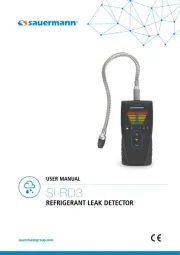
1 September 2025

20 Augustus 2025
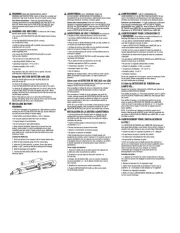
18 Augustus 2025
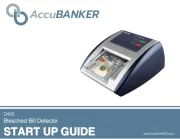
12 Augustus 2025
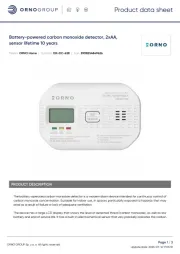
11 Augustus 2025
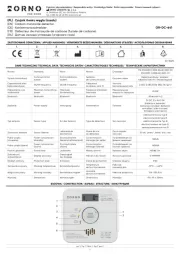
11 Augustus 2025
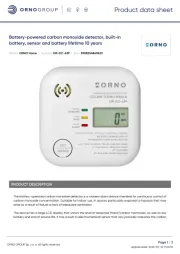
11 Augustus 2025
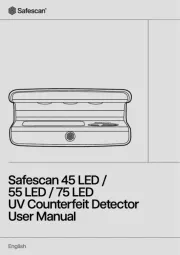
8 Augustus 2025
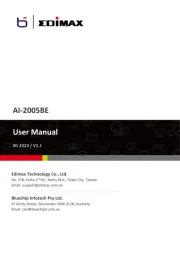
28 Juli 2025
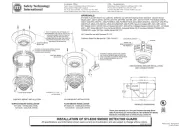
24 Juli 2025